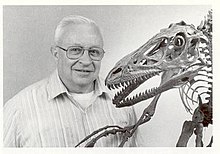John Ostrom | |
|---|---|
 John Ostrom and Deinonychus skeleton cast. Photo courtesy Yale University. | |
| Born | February 18, 1928 |
| Died | July 16, 2005 (aged 77) |
| Nationality | American |
| Alma mater | Union College (BS) Columbia University (PhD) |
| Known for | The "Dinosaur renaissance" |
| Awards | Hayden Memorial Geological Award (1986) Romer-Simpson Medal (1994) |
| Scientific career | |
| Fields | Paleontology |
| Doctoral students | Robert T. Bakker Thomas Holtz |
John Harold Ostrom (February 18, 1928 – July 16, 2005) was an American paleontologist who revolutionized the modern understanding of dinosaurs.[1] Ostrom's work inspired what his pupil Robert T. Bakker has termed a "dinosaur renaissance".[2][3]
Beginning with the discovery of Deinonychus in 1964, Ostrom challenged the widespread belief that dinosaurs were slow-moving lizards (or "saurians"). He argued that Deinonychus, a small two-legged carnivore, would have been fast-moving and warm-blooded.[4][5]
Further, Ostrom's work made zoologists question whether birds should be considered an order of Reptilia instead of their own class, Aves.[6] The idea that dinosaurs were similar to birds was first proposed by Thomas Henry Huxley in the 1860s, but was dismissed by Gerhard Heilmann in his influential book The Origin of Birds (1926).[7][8][9] Prior to Ostrom's work, the development of birds was generally believed to have split off early on from that of dinosaurs.[10]
Ostrom showed more bird-like traits common in dinosaurs and proved that birds themselves are in fact a group of coelurosaurian theropod dinosaurs.[11][6][8][12] The first of Ostrom's broad-based reviews of the osteology and phylogeny of the primitive bird Archaeopteryx appeared in 1976.[13] Ostrom lived to see the eventual discovery of feathered dinosaurs in northeastern China, confirming his theories about dinosaurs being progenitors of birds, and the existence of dinosaurs with feathered plumage.[2][14]
- ^ Stoddart, Charlotte (13 June 2023). "The fossil that launched a dinosaur revolution". Knowable Magazine | Annual Reviews. doi:10.1146/knowable-060923-1. Retrieved 20 June 2023.
- ^ a b Cite error: The named reference
Conniffwas invoked but never defined (see the help page). - ^ Bakker, Robert T. (April 1, 1975). "Dinosaur Renaissance". Scientific American. 232 (4): 58. Bibcode:1975SciAm.232d..58B. doi:10.1038/scientificamerican0475-58.
- ^ Siegel, Robert (July 21, 2005). "Influential Paleontologist John Ostrom, 77, Dies". NPR / All Things Considered. Retrieved 20 June 2023.
- ^ "In Memoriam: John Ostrom". Yale Bulletin and Calendar. 34 (1). August 26, 2005.
- ^ a b Wellnhofer, Peter (2010). "A short history of research on Archaeopteryx and its relationship with dinosaurs". In Moody, Richard (ed.). Dinosaurs and Other Extinct Saurians: A Historical Perspective. Geological Society of London. pp. 237–250. ISBN 978-1-86239-311-0.
- ^ Ries, C. J. (April 2007). "Creating the Proavis: bird origins in the art and science of Gerhard Heilmann 1913–1926". Archives of Natural History. 34 (1): 1–19. doi:10.3366/anh.2007.34.1.1. ISSN 0260-9541.
- ^ a b Havstad, Joyce C; Smith, N Adam (1 September 2019). "Fossils with Feathers and Philosophy of Science". Systematic Biology. 68 (5): 840–851. doi:10.1093/sysbio/syz010. PMC 6701454. PMID 30753719. Retrieved 21 June 2023.
- ^ Heilmann, G. (1926). The origin of birds. London: Witherby.
- ^ Galton, Peter M. (June 1970). "Ornithischian Dinosaurs and the Origin of Birds". Evolution. 24 (2): 448–462. doi:10.1111/j.1558-5646.1970.tb01775.x. PMID 28565073. S2CID 5512265.
- ^ Cracraft, Joel (1977). "John Ostrom's Studies on Archaeopteryx, the Origin of Birds, and the Evolution of Avian Flight". The Wilson Bulletin. 89 (3): 488–492. ISSN 0043-5643. JSTOR 4160962. Retrieved 21 June 2023.
- ^ Bakker, Robert T. (1986). The dinosaur heresies: new theories unlocking the mystery of the dinosaurs and their extinction (PDF) (6.print. ed.). New York: Morrow. ISBN 0-688-04287-2.
- ^ Cite error: The named reference
Rauhutwas invoked but never defined (see the help page). - ^ "Dinosaurs in Your Garden". BBC - Science & Nature. 18 October 2002.